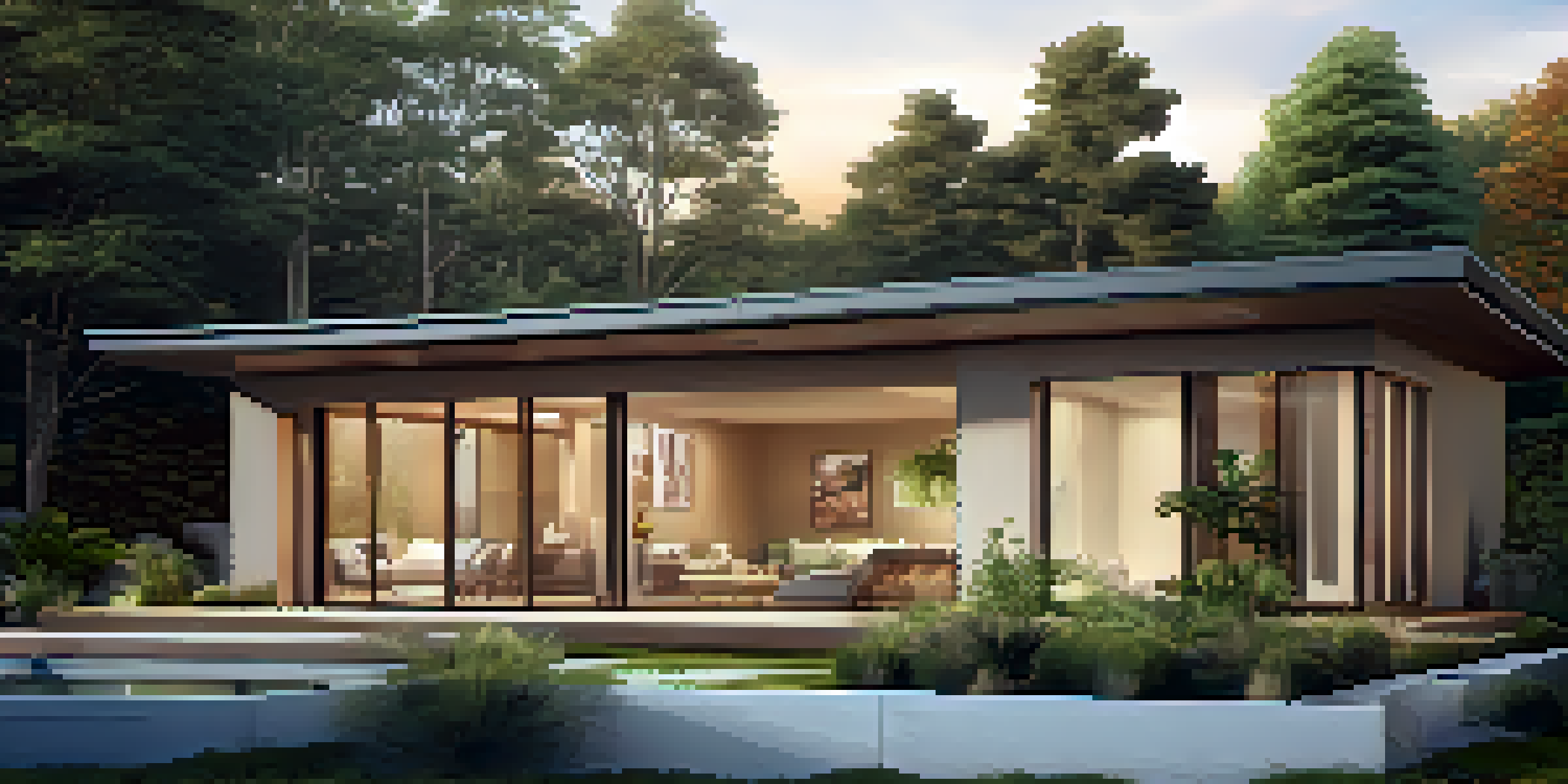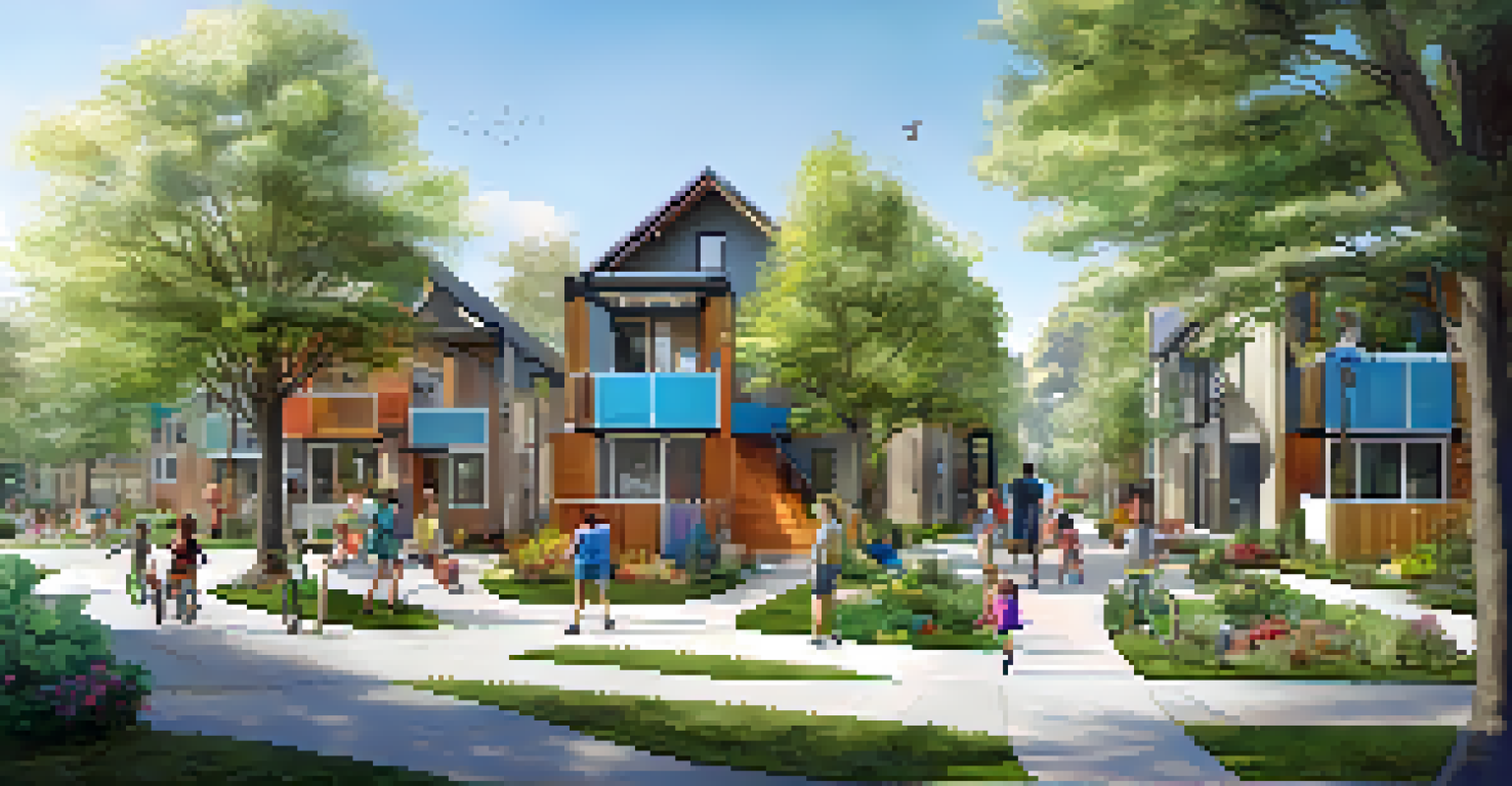The Impact of Climate Change on Home Design Trends

Understanding Climate Change and Home Design
Climate change refers to long-term shifts in temperatures and weather patterns, largely due to human activities. As awareness of its effects grows, homeowners and builders are adjusting their design strategies to reflect these changes. This shift isn't just about aesthetics; it's about creating environments that are resilient and sustainable.
The best way to predict the future is to create it.
For instance, many new homes are incorporating features that mitigate the impacts of extreme weather. This includes elevated structures in flood-prone areas or wind-resistant materials in regions prone to hurricanes. By designing with these elements in mind, architects are not only enhancing safety but also ensuring longevity.
Ultimately, understanding the connection between climate change and home design is essential for future-proofing our living spaces. As we face more unpredictable weather patterns, the integration of sustainable practices will become a standard expectation in the housing market.
Energy Efficiency: The New Standard
Energy efficiency has become a cornerstone of modern home design, driven by both environmental concerns and rising energy costs. Homeowners are increasingly seeking designs that minimize energy consumption, leading to the popularity of features like solar panels, high-performance windows, and advanced insulation materials. These elements not only reduce the carbon footprint but also significantly lower utility bills.

For example, homes designed with passive solar principles utilize natural sunlight for heating and lighting, reducing reliance on artificial sources. This approach not only promotes sustainability but also enhances comfort, making homes feel brighter and more inviting. Homebuyers are now prioritizing these features, leading to a surge in energy-efficient designs in new developments.
Climate-Smart Home Design
Home designs are evolving to incorporate features that enhance resilience to climate change and extreme weather.
As we move forward, the push for energy-efficient homes will likely continue to grow. As regulations tighten and technology advances, we can expect to see even more innovative solutions that redefine how we think about energy use in our living spaces.
Sustainable Materials: A Key Focus
The use of sustainable materials is becoming increasingly prevalent in home design, reflecting a broader commitment to environmental stewardship. From reclaimed wood to recycled metal, these materials not only reduce waste but also add character and charm to homes. Homeowners are now more conscious of the materials used in their spaces, opting for those that are both eco-friendly and durable.
We do not inherit the earth from our ancestors; we borrow it from our children.
Take bamboo, for instance; it's a fast-growing plant that can be harvested sustainably, making it an excellent choice for flooring and cabinetry. Additionally, manufacturers are creating innovative products that minimize environmental impact, such as low-VOC paints and finishes. These choices resonate with homeowners looking to create a healthier living environment for themselves and their families.
As the demand for sustainable materials rises, we can expect the design industry to innovate further. This trend is not just a passing phase; it’s a commitment to building a greener future.
Adaptive Reuse: Breathing New Life into Old Structures
Adaptive reuse is an emerging trend where old buildings are repurposed for new uses, showcasing a commitment to sustainability and creativity. Instead of tearing down existing structures, designers are finding innovative ways to breathe new life into them. This practice not only preserves historical character but also reduces waste and the need for new materials.
For example, former factories are being transformed into chic lofts, and old warehouses into vibrant community spaces. This blend of old and new creates unique living environments that tell a story, attracting residents who value character over uniformity. Moreover, adaptive reuse often comes with environmental benefits, as it minimizes the ecological footprint associated with demolition and new construction.
Energy Efficiency Takes Priority
Modern homes increasingly focus on energy efficiency with sustainable features, which reduce both environmental impact and utility costs.
As more communities embrace this approach, we can anticipate a shift in how we view existing buildings. The focus will increasingly be on preserving history while accommodating modern needs.
Smart Technology: Enhancing Home Resilience
Smart home technology is revolutionizing how we interact with our living spaces, making them more efficient and responsive to our needs. As climate change impacts become more pronounced, integrating smart technology into home design can enhance resilience. For instance, smart thermostats and energy management systems help optimize energy use, allowing homeowners to adapt to changing conditions.
Moreover, features like smart irrigation systems can conserve water while maintaining lush gardens, which is crucial in drought-prone areas. These technologies not only provide convenience but also empower homeowners to play an active role in sustainability. By monitoring energy and water usage in real-time, residents can make informed decisions that benefit both their wallets and the planet.
As the smart home trend continues to grow, we can expect even more advancements that prioritize environmental consciousness. The future of home design will undoubtedly feature technology as a key player in creating sustainable living environments.
Resilient Design: Preparing for Extreme Weather
As climate change leads to more extreme weather events, the concept of resilient design has gained traction among architects and builders. Resilient design focuses on creating homes that can withstand natural disasters, ensuring safety and longevity. This includes elevated foundations, reinforced structures, and materials that can endure high winds or flooding.
For instance, homes located in hurricane-prone areas are now often designed with aerodynamic features that reduce wind resistance. Similarly, homes in flood zones are being built with flood-resistant materials and elevated structures that minimize damage. These proactive measures not only protect the home but also offer peace of mind to residents.
Community-Centric Approaches
Designing homes with a focus on community fosters connections and resilience, helping neighborhoods thrive amid climate challenges.
The emphasis on resilient design reflects a broader understanding that our homes must adapt to a changing climate. As awareness grows, we can expect more homeowners to prioritize these crucial features in their design choices.
Community-Centric Design: Fostering Connections
As climate change reshapes our world, community-centric design is gaining importance in home planning. This approach emphasizes collaboration and connection among neighbors, fostering resilient communities that can support one another in times of crisis. Homes are being designed not just as individual units but as part of a larger ecosystem, encouraging social interaction and shared resources.
For instance, developments featuring communal gardens, shared spaces, and walkable neighborhoods promote a sense of belonging and cooperation. This design philosophy helps build community ties, making it easier for residents to respond collectively to challenges posed by climate change. The focus is on creating spaces where people can come together and share resources, enhancing resilience.

Ultimately, community-centric design recognizes that we are stronger together. As we face a changing climate, this approach will be essential in building not just homes, but supportive neighborhoods that thrive amidst adversity.